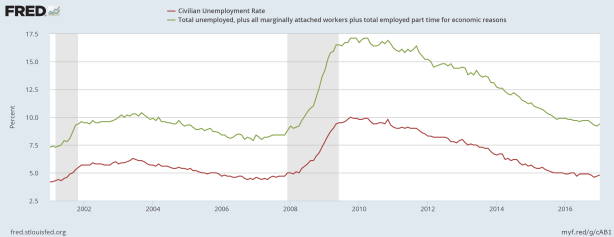From David Ruccio Readers know the old adage: in this world nothing can be said to be certain, except death and taxes. And, we should add, employers complaining they can’t find enough good workers. The fact is, if workers were really scarce, their wages would be rising dramatically. That’s how things works in a capitalist labor market: employers who want to hire workers offer higher wages. But, according to the latest report from the Bureau of Labor Statistics, average hourly earnings of private-sector production and nonsupervisory employees increased by 4 cents to .84—and weekly earnings by .34. That’s an annual rate of just 2.1 percent, the same as the rate of inflation. Workers’ wages continue to increase at a very slow rate because the situation is exactly the opposite of what employers claim: workers are not scarce, they’re abundant. While the official unemployment rate (the red line in the chart above) was 4.8 percent in January, the expanded (or U6) rate—which includes marginally attached workers and those who are employed part-time but prefer full-time jobs (the green line in the chart)—was a much higher 9.4 percent.
Topics:
David F. Ruccio considers the following as important: Uncategorized
This could be interesting, too:
tom writes The Ukraine war and Europe’s deepening march of folly
Stavros Mavroudeas writes CfP of Marxist Macroeconomic Modelling workgroup – 18th WAPE Forum, Istanbul August 6-8, 2025
Lars Pålsson Syll writes The pretence-of-knowledge syndrome
Dean Baker writes Crypto and Donald Trump’s strategic baseball card reserve
from David Ruccio
Readers know the old adage: in this world nothing can be said to be certain, except death and taxes.
And, we should add, employers complaining they can’t find enough good workers.
The fact is, if workers were really scarce, their wages would be rising dramatically. That’s how things works in a capitalist labor market: employers who want to hire workers offer higher wages.
But, according to the latest report from the Bureau of Labor Statistics, average hourly earnings of private-sector production and nonsupervisory employees increased by 4 cents to $21.84—and weekly earnings by $1.34. That’s an annual rate of just 2.1 percent, the same as the rate of inflation.
Workers’ wages continue to increase at a very slow rate because the situation is exactly the opposite of what employers claim: workers are not scarce, they’re abundant.
While the official unemployment rate (the red line in the chart above) was 4.8 percent in January, the expanded (or U6) rate—which includes marginally attached workers and those who are employed part-time but prefer full-time jobs (the green line in the chart)—was a much higher 9.4 percent.
Meanwhile, the civilian employment-population rate (the ratio of total civilian employment to the civilian noninstitutional population or, more simply, the portion of the adult population 16 years and older that is employed) was still below 60 percent—and thus far less than its pre-crash peak (in December 2006) of 63.4 percent.
There are in fact plenty of potential workers out there—in the labor force and in the larger working-age population. But employers would rather complain than pay higher wages to hire them.



